2020 Yeti SB130 T1
Test Location: Gunnison-Crested Butte Valley, Colorado
Test Duration:
- David Golay: 3 rides
- Dylan Wood: 16 rides
Reviewers:
- David: 6’0″, 165 lbs
- Dylan: 5’11”, 155 lbs
Size Tested: Large
Geometry: See Below
Build Overview (T1 Build):
- Drivetrain: Shimano XT M8100 12 speed
- Brakes: Shimano XT M8120 4 piston
- Fork: Fox Factory FIT4 36
- Shock: Fox Factory DPX2
- Wheels: DT Swiss M1700
Wheel Size: 29”
Travel: 130 mm rear / 150 mm front
Blister’s Measured Weight (as built, without pedals): 30.375 lbs / 13.78 kg
MSRP (T1 Build): $6,799
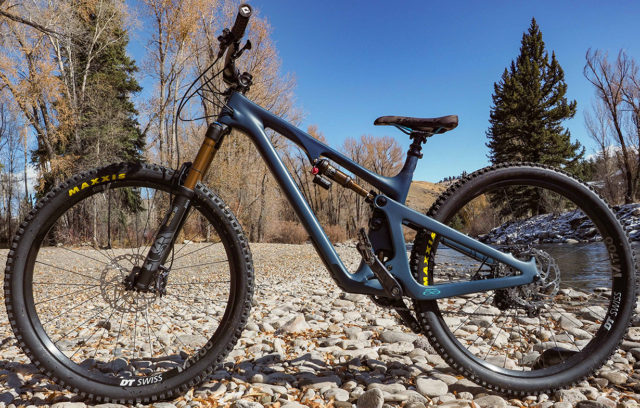
Intro
We’re finally getting time on the SB130, Yeti’s 130mm-travel 29er Trail bike, and below we’ve posted our updated on-trail impressions now that two of our reviewers have been able to spend time on it here in the Gunnison Valley. But first, we wanted to talk a bit about the specs of the bike and what sets it apart from the crowded field of ~130mm-travel Trail bikes.
Yeti says this about the SB 130: “The rebel yell of the middle child. Fed a steady diet of super-tech climbs. The SB130 was built to crush the biggest terrain. No trail ‘too’ anything. Point it up or down. Enter a last-minute enduro just for the eff of it. We say no one bike can rule all. But the SB130? One bike that rules.”
Weird syntax aside, they seem to be positioning the SB130 as a versatile bike that can cover a lot of bases, which makes sense for a mid-travel bike with modern geometry.
While it’s not a totally apples-to-apples comparison, the SB130 could be thought of as a 29er replacement for the SB5 (at least in terms of how Yeti markets both bikes), which we reviewed and found to be a capable all-arounder, but one that was a bit more game-on and less cushy than some other bikes in the class. Compared to the SB5, the SB130 gets a slightly more progressive leverage curve, a slacker headtube angle (65.5° vs 66.5°), a longer reach (by ~25 mm, depending on size), and slightly shorter chainstays (and obviously different-sized wheels). That should change the balance and character of the bike significantly – the front center got much longer, while the chainstays lost a few mm – so we were excited to see how the SB130 compared.
The Frame
Yeti debuted their SB – as in “Super Bike” – series of bikes with the SB66, in 2011. The defining feature of the line is Yeti’s patented “Switch Infinity” suspension linkage, a design that features a lower link that reverses the direction of travel in the middle of the stroke. The result is, in effect, a linkage-driven single pivot, but one where the main pivot location moves up and down slightly as the bike cycles through its travel. Or you could think of it as a parallel link design, a-la the DW-Link design, but with a lower link that reverses its direction of rotation mid-stroke.
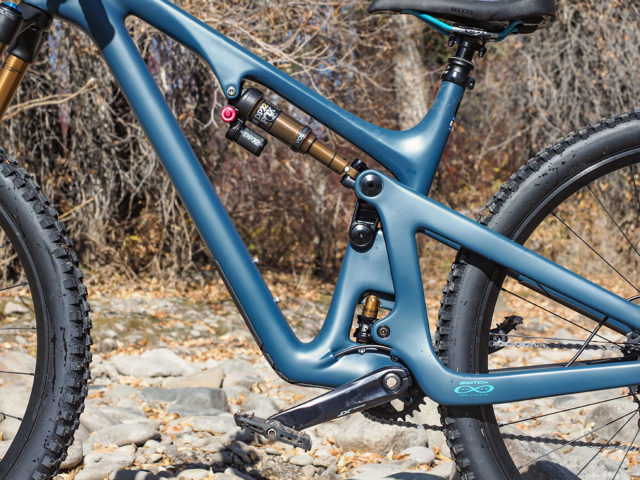
Yeti offers the SB130 only with carbon frames (amusingly, the page for the SB130 on the Yeti website features a welding photo as one of the background images), but with two varieties of carbon layup. The base “C” carbon frame is offered on the three least-expensive complete builds, and the higher-end “Turq” frame comes in a couple hundred grams lighter, and is specced on the higher-end builds, as well as the frame-only option.
The SB130 uses internal cable routing all around, a press-fit BB92 bottom bracket, and ISCG ‘05 tabs. The downtube features a large rubber guard, which includes a port with a bolt-on cover just in front of the bottom bracket to help make cable routing easier, and a water bottle can be mounted down low inside the front triangle.
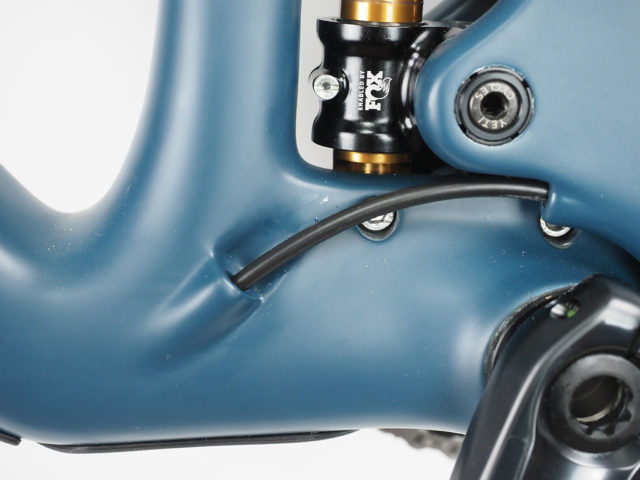
The leverage curve of the SB130 is moderately progressive — roughly 2.6:1 to 2.3:1, which is considerably less progressive than the Santa Cruz Hightower or Specialized Stumpjumper, but more progressive than the Ibis Ripmo. The SB130’s leverage curve is also pretty straight, without any weird inflection points to tune around. Its anti-squat values are a little over 110% through the first 40% of the travel, and then fall off dramatically from there – a setup that should result in solid pedaling performance, with a bit better than average decoupling of suspension action from the pedals deeper in the travel.
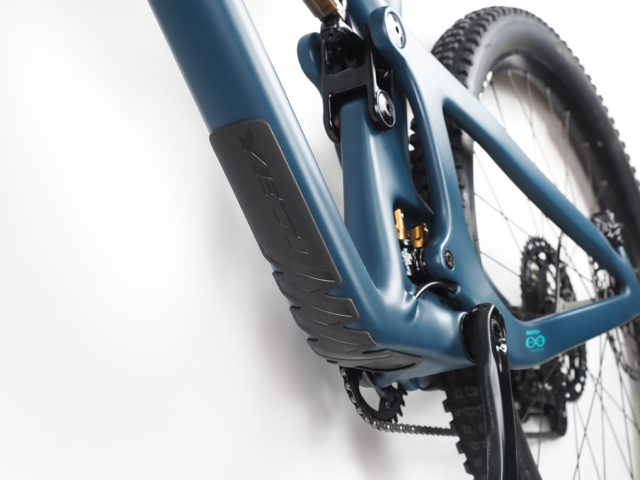
The Builds
The SB130 is offered in seven complete builds, starting with the C1 that’s equipped with a Sram GX drivetrain and Fox Performance 36 and DPX2 suspension for $5399. At the top end, there’s the T3 build that comes with a Sram XX1 drivetrain and Fox Factory suspension at $8199. We’re testing the mid-spec T1 build, with a Shimano XT 12-speed drivetrain and XT brakes, and a Fox Factory 36 Fit4 and Factory DPX2, which retails for $6799.
Yeti also offers two “LR” (stands for “lunch ride”) builds for the SB130, the CLR and TLR, which bump up the rear travel to 137 mm via a longer-stroke shock, come with 160mm-travel forks, and include beefier brakes (Sram Codes) and tires (Exo+ casings, and a 2.4” DHR II rear tire in place of a 2.3” Aggressor). An SB 130 frame with a Fox Factory DPX2 (in the 130mm-travel size) goes for $3499.
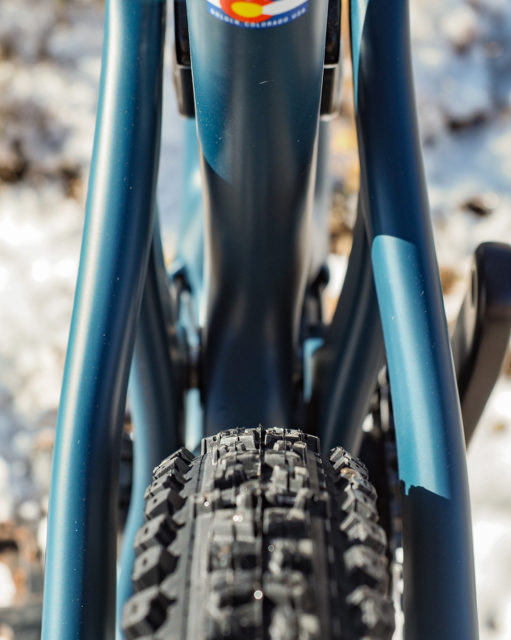
For reference, here are all the currently available SB130 builds and some of their most notable specs:
SB130 C1
- MSRP: $5399
- Fork: Fox Performance 36 (150 mm)
- Shock: Fox Performance DPX2
- Drivetrain: Sram GX Eagle
- Brakes: Sram Guide R
SB130 C2
- MSRP: $5999
- Fork: Fox Performance 36 (150 mm)
- Shock: Fox Performance DPX2
- Drivetrain: Sram GX Eagle
- Brakes: Sram G2 RSC
SB130 CLR
- MSRP: $5499
- Fork: Fox Performance 36 (160 mm)
- Shock: Fox Performance DPX2 (longer-stroke version)
- Drivetrain: Sram GX Eagle
- Brakes: Sram Code R
SB130 T1
- MSRP: $6799
- Fork: Fox Factory FIT4 36 (150 mm)
- Shock: Fox Factory DPX2
- Drivetrain: Shimano XT
- Brakes: Shimano XT
SB130 T2
- MSRP: $7299
- Fork: Fox Factory FIT4 36 (150 mm)
- Shock: Fox Factory DPX2
- Drivetrain: Sram X01 Eagle
- Brakes: Sram G2 RSC
SB130 T3
- MSRP: $8199
- Fork: Fox Factory FIT4 36 (150 mm)
- Shock: Fox Factory DPX2
- Drivetrain: Sram XX1 Eagle
- Brakes: Sram G2 RSC
SB130 TLR
- MSRP: $7599
- Fork: Fox Factory GRIP2 36 (160 mm)
- Shock: Fox Factory DPX2 (longer-stroke version)
- Drivetrain: Sram X01 Eagle
- Brakes: Sram Code RSC
SB130 Frame-Only
- MSRP: $3499
- Shock: Fox Factory DPX2
Fit and Geometry
As with most modern bikes in the class, the SB130 features reach and seattube angle numbers that would have seemed quite long and steep (respectively) just a few years ago. The size Large SB 130’s reach comes in at 480.2 mm and it offers an effective seattube angle around 77° on all sizes – with an unpublished, but steep actual angle to boot. The headtube angle sits at 65.5° across the board, and all sizes get 433 mm chainstays. The CLR and TLR builds’ geometry is slightly different due to the longer fork, slackening the head angle to 65.1°, the effective seattube angle to 76.6°, and shortening the reach slightly to 475.6 mm (size Large).
All of this is is pretty conventional stuff for a contemporary Trail bike, and should make for a versatile ride. There are certainly more aggressive ~130mm-travel bikes out there, and many others with more of an XC bent, but the SB130 looks to sit in a middle ground that should work well for a lot of riders.
For reference, here’s the geo chart for the standard SB130 frame. You can find the geometry chart for the CLR and TLR versions here.
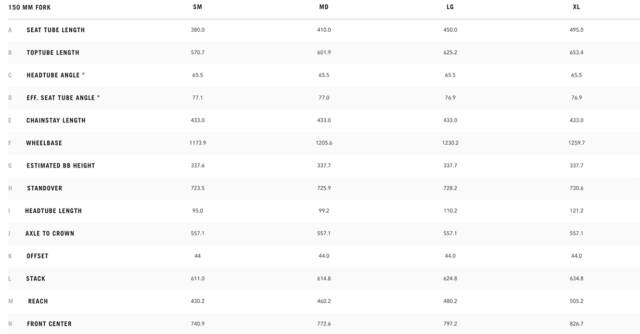
Some Questions / Things We’re Curious About
- What sort of riders are going to get along best with the SB130, and where does it fit into the range of mid-travel Trail bikes on the market? Does it punch a bit above its travel (especially given that it’s a bit over-forked, at 150 mm of front travel), or does it feel like a conventional 130mm-travel bike?
- How similar or different does the SB130 feel compared to the SB5 that it replaced? On paper, the geometry changes are significant, but not totally night and day, and Yeti seems to be describing them in similar terms.
- How does the new Shimano XT 12-speed drivetrain compare to Sram’s Eagle offerings?
Bottom Line (For Now)
The SB130 looks like a solid update to the old SB5, and one that should be appealing to a lot of riders. But how does it compare to the old bike, and the current crop of mid-travel 29er trail bikes? Reviewers David Golay and Dylan Wood have now spent time on the SB130, and below you can check out their on-trail impressions.
Update, 5.26.20
David Golay (6’0″, 165 lbs): I got three days on the SB130, unfortunately in less than ideal conditions (right as it was beginning to look more like ski season than bike season in Crested Butte…). But it was enough time to form some initial impressions about the bike.
Dylan Wood (5’11”, 155 lbs): I’ve been riding the SB130 a lot this spring in Gunnison, primarily around the rocky terrain at Hartman Rocks just outside of Gunnison, so I’ve tacked on my thoughts to David’s initial impressions.
Fit and Geometry
David: At 6’ 0” tall, I’m squarely in the middle of Yeti’s recommended height range for a size Large, and I’d agree with that sizing for my height; at 480.2 mm, its reach is on the long side of average for a size Large, but a bit shorter than some other bikes I’ve been spending time on lately (notably my Nicolai G16, which has a reach of 500 mm). With a 50 mm stem, the sizing of the SB130 felt appropriate for a more nimble, mid-travel Trail bike.
Yeti’s recommended sizing band for the Large goes up to 6’ 3”, but I think that most riders that tall will be better served by the XL. The recommended range for that size starts at 6’ 1”, so there’s a bit of overlap. If you’re in the overlapping region between sizes, I wouldn’t be shy about bumping up, especially if you’ve got some time on longer modern bikes and have gotten along with that kind of geometry.
I wouldn’t mind seeing the SB130 come specced with an 800mm-wide bar (which the TLR build does; all others get a 780 mm). It’s easy to cut a bar down, but going the other way requires a swap, so going big makes it a little easier to set up to a rider’s preferences. That said, the 780 mm is probably adequate for a lot of people on a Trail bike – I’d feel a lot more strongly about this on a longer-travel Enduro bike than I do with a Trail bike like the SB130.
Dylan: At 5’11”, I am on the shorter side for Yeti’s size chart for the size Large SB130, though still within their recommended range. Overall, I’ve found that both seated and standing climbing feels very good and descending feels great, too. The SB130 has enough space to shift my weight around and the weight distribution between front and rear tires feels balanced.
I definitely wouldn’t want to be on a Medium, and I agree with David about bumping up if you’re caught between sizes and are looking at a bike like the SB130 with fairly progressive geometry. The only problem you might run into would be achieving your seat height with the stock 170 mm dropper. I have a seat height of 76 cm, and I only have a centimeter or two of space between the seat collar and the dropper’s lowest possible insertion point. If you have shorter legs, you might need to size down to a 150 mm dropper.
As far as handlebars go, I don’t personally mind the 780 mm bars. For me, they feel appropriate for this bike’s intended use and I don’t find them that far off from 800 mm bars in terms of ride feel. But as David noted, the issue of being able to cut down a wide bar and not lengthen a short one is something to consider.
The Ride
David: For a mid-travel 29er Trail bike with fairly progressive (i.e., long) geometry, the SB130 feels like it falls near the middle of the spectrum, from nimble / poppy to stable / hard charging. Its pedaling performance is respectable, but it’s clearly set up to perform well on the way back down more than it wants to be a rocket ship under power. With the climb switch on the DPX2 disengaged, there was an appreciable, but not excessive amount of rear suspension movement under hard, seated pedaling efforts. Locking out the shock mitigated this a bit, but the DPX2 (at least in the tune spec’d on the SB130) doesn’t have an especially firm climb mode — it firms things up a touch, but isn’t anything close to a true lockout.
That said, I wouldn’t characterize the suspension performance of the SB130 as being exceptionally plush, either. Mid-stroke support is solid, but the SB130 accomplishes this without a hugely progressive leverage curve, which makes the bike harsher on mid-size hits. I think it’s a good balance between supportive and compliant for a bike in this travel range; riders looking for the most supple, easy-going Trail bike might be better off looking elsewhere, but the SB130 strikes a great balance of being able to be pushed hard, without being so demanding that it requires it at every moment.
The Fox Factory 36 Fit4 also performed well for the most part, though I wish the Grip2 damper was an option. Unfortunately, Fox doesn’t currently offer the 36 in a 29er, 150mm-travel version (at least in aftermarket options), though I imagine that Fox could make one for Yeti since they’re much more flexible when it comes to OEM products (e.g., Transition specs a 140mm-travel 36 with a Grip2 damper on the Smuggler, and Orbea specs a 150mm-travel 36 with a Grip2 damper on their Occam). Regarding the Fit4, I’m all for climb modes on rear shocks on Trail bikes, where they do make a significant difference in pedaling performance. But (1) front suspension movement under pedaling input tends to be much less pronounced than it is in the rear shock and (2) firming up the front suspension for climbing has the undesirable side effect of causing the fork to ride higher in its travel, making it harder to keep the front wheel planted on steeper climbs.
I didn’t have many specific gripes with the Fit4 damper in my brief time on the SB130, but I was never tempted in the slightest to take the fork out of open mode, and so there’d be no real drawback (for me, anyway) to Fox offering the better performing and more tunable Grip2 damper for a bike like the SB130. (The TLR build does get a 36 Grip2 with 160 mm of travel; the other Turq builds come with the Fit4 fork, and the C builds all get a Performance version with the base Grip damper.)
The handling of the SB130, once again, felt like a good, versatile middle ground. It certainly doesn’t offer the razor-sharp handling of a shorter, steeper bike, but feels much more composed at speed and on steep terrain than the most nimble, XC-oriented Trail bikes, while still being sprightly enough to be fun on more rolling, mellow terrain.
Dylan: I am mostly in agreement with David here. The SB130 definitely feels long, and that correlates to confidence-inspiring stability in rough terrain (particularly for this travel class). On the other side, you can definitely feel how long it is when navigating steep, tight switchbacks. The SB130 feels best when it’s going fast, and that’s not a big surprise given its geo numbers.
I’ve been quite impressed by the way the SB130 pedals. I’ve always been a fan of Yeti’s Switch Infinity suspension for this reason. The SB130 feels composed when you need to put a lot of power down to get up steep climbs or technical maneuvers, doing a decent job of absorbing bumps and maintaining traction while still feeling efficient. The suspension of the SB130 allowed for predictable and consistent pedaling, even while smashing it into some rocks on punchy climbs and going well into its travel. Stand up and attack on a smooth surface like a road, and yes, you’ll notice some pedal bob. That shouldn’t be too much of a surprise, and it feels better in this regard than many other bikes with more travel (e.g., Yeti SB150).
The SB130’s suspension doesn’t feel exactly plush to me, either, and I don’t personally see that as a bad thing. The bike will absorb small chatter and does not feel completely overwhelmed by big hits, and it allows me to push it into corners and pump hard over features without all of that energy going into the bike’s suspension. However, on some of the faster g-outs and bigger drops, it wasn’t uncommon for me to bottom out the rear suspension, even while running about 30% sag. I think a few volume spacers in the rear shock ought to cure this, and I plan on installing some soon.
About the Fit4 damper vs. Grip2 damper: I don’t see as much of an issue with Yeti putting a Fit4 on this bike. I think there are many people out there who will appreciate the simplicity of the setup and the lockout feature for pedaling on flat and smooth roads. If you’re someone who loves the adjustability of the Grip2 damper and want a Yeti SB130, it’d be worth checking out the “Lunch Ride” edition of the SB130, where the fork does indeed have a Grip2 damper.
The Shimano XT Groupset
Drivetrain
David: While we certainly don’t yet have enough time on the Shimano XT 12-speed drivetrain to comment on its long-term durability, its shifting performance — especially under load — is impressive. Compared to Sram’s Eagle offerings, shifter action is lighter, and the ability to upshift two gears with a single stroke is welcome.
Dylan: I agree, the XT drivetrain has been very effective and reliable thus far on the SB130. Its performance while shifting under load has made me like it more than any Sram Eagle drivetrain I’ve been on, and the shifter also feels very crisp and ergonomic. The ability to upshift two gears with one simple motion on Shimano shifters may not be an entire selling point on its own, but it surely is another luxury of the 12-speed XT drivetrain.
Controls
David: The only issue I had is that the unusually wide clamp of the XT brakes meant that the shifter needed to be set a touch further inboard than I would have liked, for optimal ergonomics. The brake lever’s clamp sits unusually far inboard, and has a small nub that rests against the bar to reduce flex, just inboard of the grip, preventing the brake lever from being moved further out. Using the integrated iSpec shifter / brake mount might have taken care of this, but the SB130 wasn’t spec’d as such. It wasn’t a major issue, and the shifter wasn’t far off from where I would have ideally placed it, but it did strike me as a surprising rough edge on what was otherwise a very well polished product. (Reviewer Banks Kriz has also been using the XT 12-speed drivetrain on the Trek Fuel EX, so we’ll both be weighing in on it after we’ve spent much more time using these bikes.)
Dylan: I swapped the shifter / dropper lever and the brake levers on both sides of the handlebars (so that the brake levers are inboard of the other controls), and it’s made for a comfortable and functional cockpit. You have to put the shifter and dropper lever in between the brake lever clamps and the braces against the bar that David mentioned above, but it’s worked well for me. Shoutout to local bike mechanic Ian Mullens for showing me this trick.
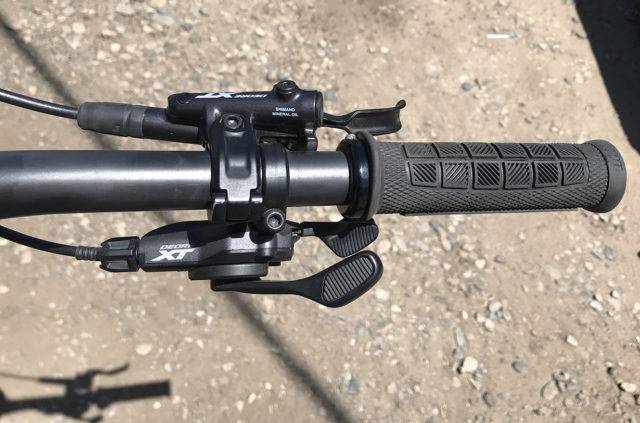
Bottom Line
David: My initial impression of the SB130 is that it’s a very competent mid-travel Trail bike that would be easy to recommend to a lot of riders looking for a versatile 29er Trail bike, particularly for those who’d happily trade a little plushness for more poppy, supportive suspension.
Dylan: The Yeti SB130 has been a blast to ride on a variety of terrain. I think a lot of intermediate to expert riders could get along with this bike on a variety of trails. It rewards aggressive riding and has a pretty efficient pedaling platform to help you get to the top of your favorite descents. That being said, the Yeti SB130 is not my first recommendation for beginner to intermediate riders. The length of the bike, combined with not-so-forgiving suspension, could make it harder for new riders to learn the fundamentals of mountain biking. But if you’re looking for a mid-travel 29er and favor straight-line stability over forgiveness and snappy handling, it definitely warrants consideration. We’re also planning on spending more time on the bike and hopefully having Eric Freson give it a try, so stay tuned for further updates.

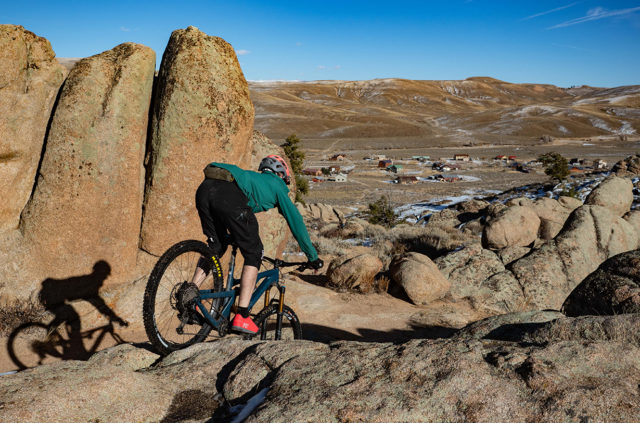
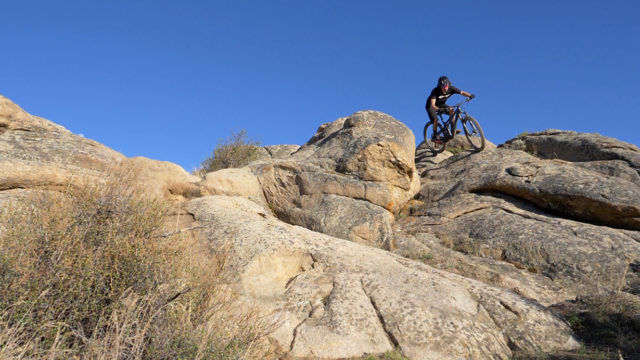
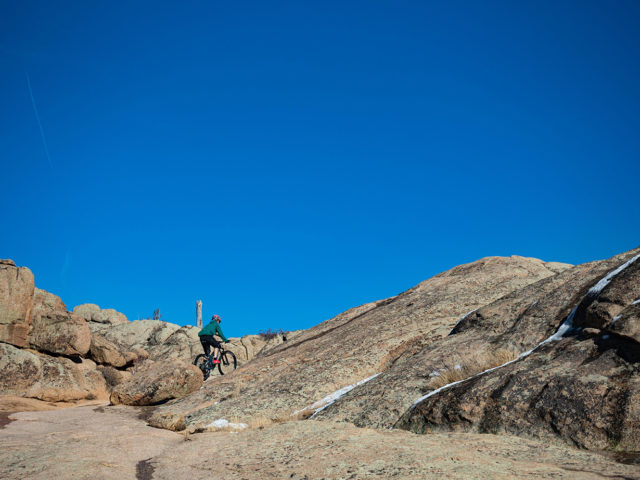
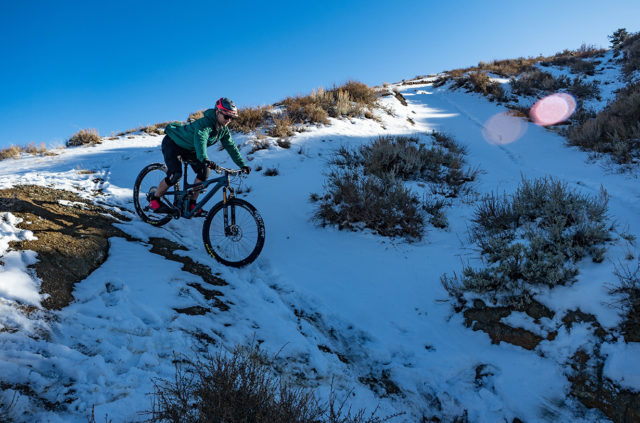
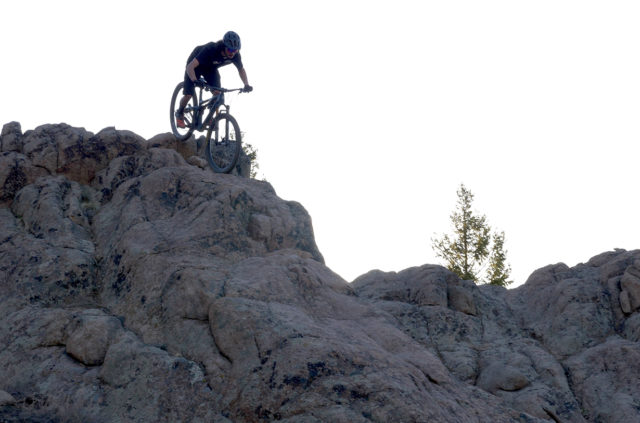
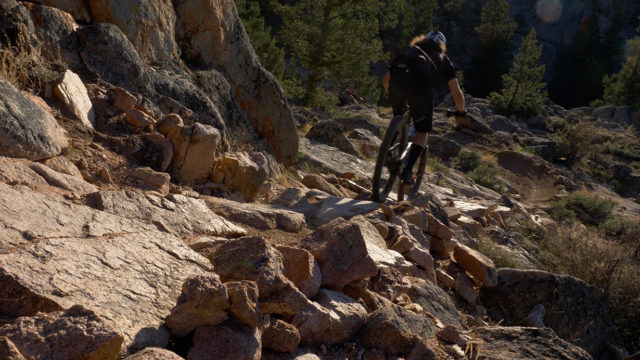
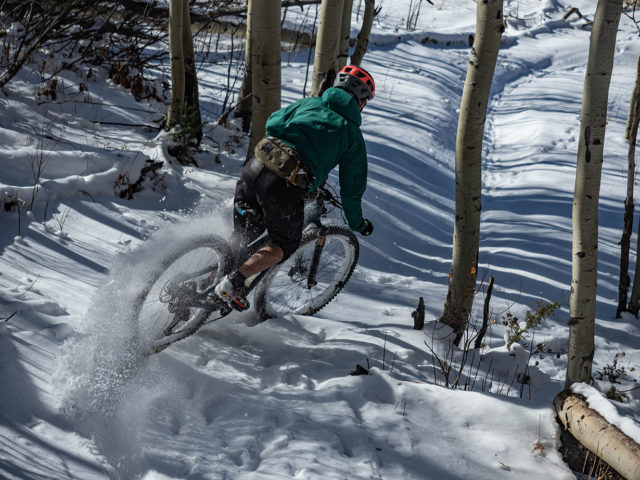
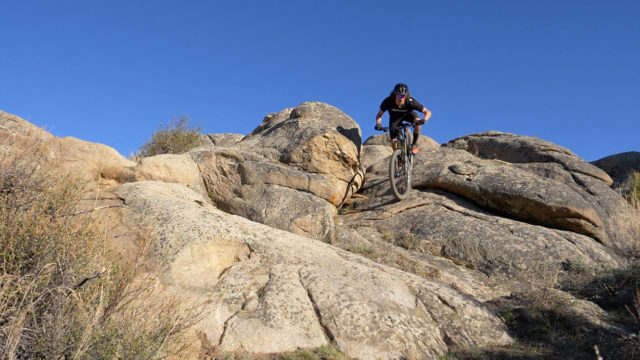
Been riding it for over 6 months.
I think it does fit for aggressive trail riders up to enduro racing. (Especially in the LR edition) Anyone racing enduro I’d push towards the SB150.
Friend of mine switched from the SB5 to the 130. Other than the wheel size difference he felt they notched in similarly.
Seems like an oddly aggressive build for a 130mm bike at all price points when it could easily be built up at or even under 30lbs with a non-piggyback shock, 34 fork, 2 piston brakes with Icetech rotors instead of quad piston, and of course slimmer tires. It would still be super capable, and you could just go with the “lunch ride” spec or the 150 if you needed more.
Maybe it’s just because I live in Missoula and am a total gaper, but what is the purpose of piggypack shocks on 140mm or less travel bikes? Enlighten me.
The SB130 probably is a bit to the aggressive side of center when it comes to build (and geometry) among the class of 130mm travel bikes out there, but I think there’s absolutely a place for that. That might mean it’s not the right bike for everyone (nothing is), but there are plenty of people out there, myself very much included, who are pretty excited about the idea of a shorter travel bike that maintains a bit of the pop and nimbleness that you lose with a ton of suspension, but that can still be pushed hard. Options in the market are good, and I’d be bummed if there wasn’t a bit of variety within a given class of bike, as determined by suspension travel.
As far as the piggyback shock goes, they do offer better suspension performance, particularly in terms of heat management on sustained descents. On a bike like the SB130, I think that spec choice makes total sense.
The SB130 replaced the SB5.5 or SB4.5 depending on how you interpret the splitting of their previous bike line up. Not the SB5 which was a 27.5 bike
I guess it depends how you want to look at it – if you view common wheel size as a hard requirement to count as a successor, you’re right. My thinking is that, wheel size notwithstanding, the SB5 was closest to the SB130 in terms of intended use. There are plenty of bikes out there where the 27.5 option has been dropped or replaced entirely with a new 29er, so I don’t view that as a hard break necessarily. But it’s certainly open to interpretation.
I agree with Greg the SB130 is more like a replacement of the SB5.5, even when you don’t take into account the wheel size.
The SB130 is not a SB5 replacement. That title goes to the SB140. Additionally, ignoring wheel size in comparing/reviewing mountain bikes would be an error on the egregious scale that rivaled ignoring the waste width of a ski. In effect, you CANT ignore wheel size. The differences between a 29er and 27.5 are that stark. Cheers.
Hey Ben,
I’m of course not arguing that wheel size doesn’t matter and isn’t worth paying attention to. Rather, Yeti talked about the SB130 in very similar ways to the SB5, and positioned it for similar use within their lineup. So, yes, if you were looking to move on from an SB5, and were set on sticking with 27.5 wheels, the SB130 wouldn’t be the answer. I meant that comparison in terms of intended use (which I think is very valid) but you are right that it’s not a perfectly direct carryover to a nearly identical bike either. We’ve tweaked the language to hopefully be a bit more clear on that. Hope that helps.
Thanks for the response David. This is why Blister is and will always be the best gear review site out there. I’m signing up today, no more lurking.
Your point about how Yeti positions the SB130 is a valid one in that Yeti has bifurcated their lineup into “race” and “rip” categories. What does the SB130 improve upon? The down-for-anything nature of the SB5.5, or the trail ripper aesthetic of the SB5? I’m not saying that every time a bike is released we should know the bike it replaces. That’s a poor ideal. But for the life of me, I have no idea what Yeti is doing with their storytelling. Thanks again for your response.
Ben, thanks for the kind words, and glad to have you on board!
You’re absolutely right that any given bike needn’t be a direct replacement for anything in particular, and I probably could have been more careful about how I wrote about it given the slightly murky lineage. We’ll be updating this post soon with some first ride impressions, but in short the SB130 feels like a fairly nimble, sprightly Trail bike – and a good one – rather than something blurring the lines between that and a burly Enduro sled.
Fox actually doesn’t make a factory 150mm 29 fork with the grip 2. I’m sure yeti would love to spec it.
You’re right that they don’t sell that combo aftermarket, but Fox offers a lot more versions for OE spec – see, for example, the 140mm Grip2 on the Transition Smuggler. We’ve updated the post to be more clear on this point, but the fact that Fox doesn’t sell it aftermarket doesn’t mean that Yeti couldn’t have spec’d it.
A ~$35 airshaft in 150 mm and you’re on your way?
Nice write-up. I couldn’t agree more with the characterization of a versatile trail bike that trades a little plushness for a bit more mid-stroke support and—for lack of a better term—abruptness. In fact, in “regular” SB130 guise (i.e., not the LR version), I’d go so far as to say that the SB130 is a bit on the downcountry side of things.
I think that the bike fits a whole host of riders from an intent perspective. That said, this bike screams for a 160mm fork and for a bit more plushness in the rear. Most manufacturers are debuting their aggressive trail bikes with 140mm of rear travel and that number just seems to resonate on so many levels. An aside, did you experience any pedal strike issues? The length of the bike combined with the new kink in the down tube seemed to make the breakover angle and associated crank arm proximity to the ground a real issue when I rode the bike.
Yeah, I think that’s probably why Fox doesn’t offer every possible combination of travel configuration out of the box aftermarket – they can get away with it because changing the travel with an air shaft is cheap and easy, and not having to stock and distribute every possible combination is considerably easier on their end.
They’ll still make them for OEs though, if they’re buying in bulk. The Orbea Occam, for example, is available with a 150mm Factory Grip2 29er fork.
Hello David
Excellent review, very detailed.
I am actually 6ft tall and coming from a XC background, i was wondering if a size Large would be ok for me along with a 60/50mm stem
I also like the pics from gunnison as i rode hartmans rock with Brian Riepe from Mountain Flyer
Keep on going with ur good work
best regards
Fabrice the frenchie
I bought the most expensive version of this bike. Shuttled to the top of the mountain with my stocklis. Couldn’t figure out if it was raining or snowing so shuttled back down. I’ll try again next year.
I’ve had a custom TURQ SB130 now for just a week. The front fork is a 140 so some effect on geometry. It weighs in @ 29.5 lbs vs the 27.5 lb 575 that it’s replacing. Climbing is about the same…better over obstacles but it does feel longer and the extra weight might be a factor. But this thing just rips descents that used to hold me back. I’m sure there are easily a dozen more choices out there that would be as good or better. But overall, for a rider who powers their own ascents 99.5% of the year, this is a dream bike for me and makes me want to ride every day.
Wonderful review, gents. TY. I’m deciding between the Trek Fuel EX and the SB130. I saw that one of your colleagues is riding the Fuel EX so I’m hoping you both have some time with that bike as well. I’m super torn. I currently ride a 2018 Fuel EX 9.9. I love the bike for its light weight, snappiness, and good pedaling, although it feels a little short and I long for a bit more cush. I recently demo’d an SB130 while in Asheville, NC and fell in love. I immediately noticed the longer cockpit and the seat tube angle felt immediately at home. This being said, the trails I rode in Asheville were a bit more flowy than what I typically ride in Eastern Pennsylvania where I ride a more rocky and rooty terrain with short punchy climbs and short technical descents. Unfortunately there are very few Yeti dealers in the area and I can’t get a demo to test on my own trails. I have a Trek dealer 5-blocks away with a staff that always impresses. I’m an experienced, 52-year old, 170lb, rider that has years of racing XC at the Expert/Cat 1 level but now just like to get out and push it with some friends and maybe shoot for a Strava segment. Help end my mental torture…make the call for me ;-)
Hi John
Have you made the call yet, what bike did you choose. Having same dilemma.
Cheers
Carlton (NZ)
any word on the pedal strike query?
My 2021 SB130 T1 lunch ride size large weights with pedals 32.6lbs.